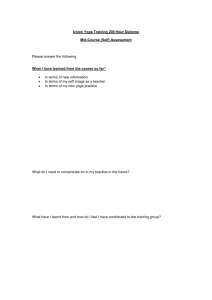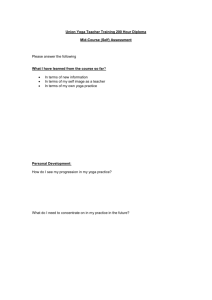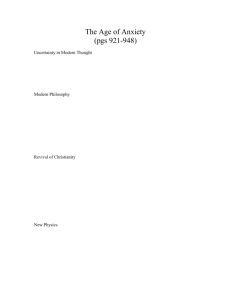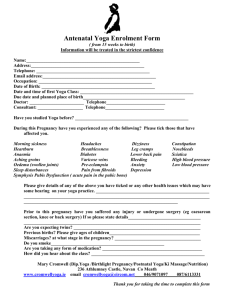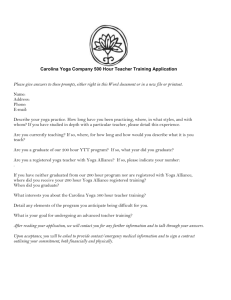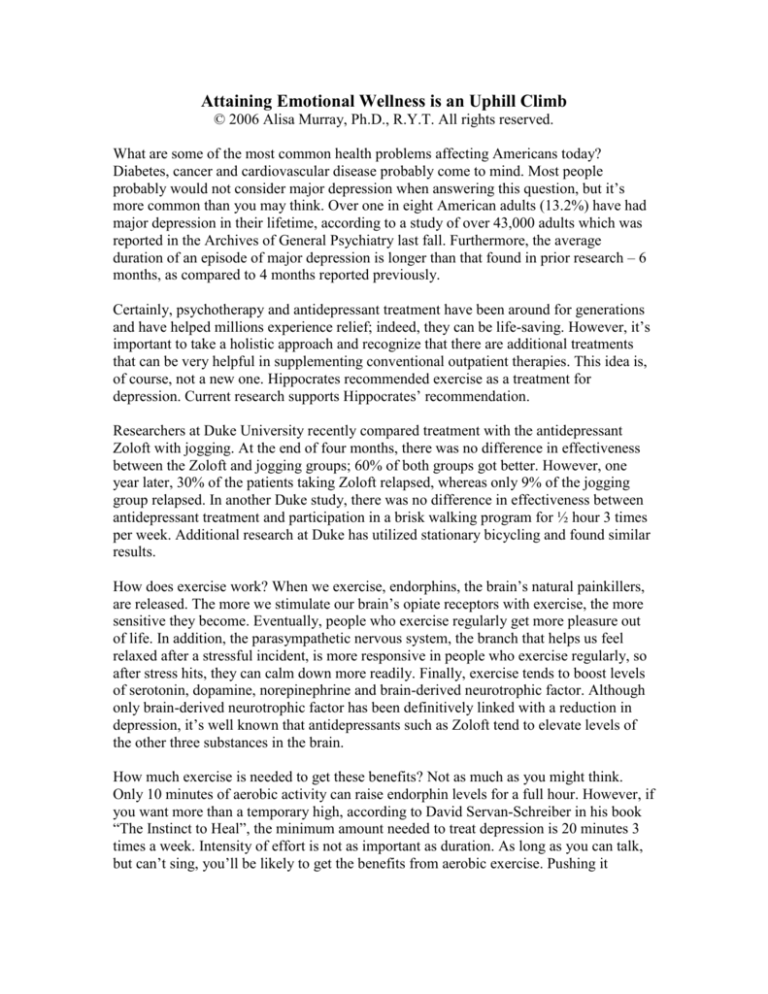
Attaining Emotional Wellness is an Uphill Climb
© 2006 Alisa Murray, Ph.D., R.Y.T. All rights reserved.
What are some of the most common health problems affecting Americans today?
Diabetes, cancer and cardiovascular disease probably come to mind. Most people
probably would not consider major depression when answering this question, but it’s
more common than you may think. Over one in eight American adults (13.2%) have had
major depression in their lifetime, according to a study of over 43,000 adults which was
reported in the Archives of General Psychiatry last fall. Furthermore, the average
duration of an episode of major depression is longer than that found in prior research – 6
months, as compared to 4 months reported previously.
Certainly, psychotherapy and antidepressant treatment have been around for generations
and have helped millions experience relief; indeed, they can be life-saving. However, it’s
important to take a holistic approach and recognize that there are additional treatments
that can be very helpful in supplementing conventional outpatient therapies. This idea is,
of course, not a new one. Hippocrates recommended exercise as a treatment for
depression. Current research supports Hippocrates’ recommendation.
Researchers at Duke University recently compared treatment with the antidepressant
Zoloft with jogging. At the end of four months, there was no difference in effectiveness
between the Zoloft and jogging groups; 60% of both groups got better. However, one
year later, 30% of the patients taking Zoloft relapsed, whereas only 9% of the jogging
group relapsed. In another Duke study, there was no difference in effectiveness between
antidepressant treatment and participation in a brisk walking program for ½ hour 3 times
per week. Additional research at Duke has utilized stationary bicycling and found similar
results.
How does exercise work? When we exercise, endorphins, the brain’s natural painkillers,
are released. The more we stimulate our brain’s opiate receptors with exercise, the more
sensitive they become. Eventually, people who exercise regularly get more pleasure out
of life. In addition, the parasympathetic nervous system, the branch that helps us feel
relaxed after a stressful incident, is more responsive in people who exercise regularly, so
after stress hits, they can calm down more readily. Finally, exercise tends to boost levels
of serotonin, dopamine, norepinephrine and brain-derived neurotrophic factor. Although
only brain-derived neurotrophic factor has been definitively linked with a reduction in
depression, it’s well known that antidepressants such as Zoloft tend to elevate levels of
the other three substances in the brain.
How much exercise is needed to get these benefits? Not as much as you might think.
Only 10 minutes of aerobic activity can raise endorphin levels for a full hour. However, if
you want more than a temporary high, according to David Servan-Schreiber in his book
“The Instinct to Heal”, the minimum amount needed to treat depression is 20 minutes 3
times a week. Intensity of effort is not as important as duration. As long as you can talk,
but can’t sing, you’ll be likely to get the benefits from aerobic exercise. Pushing it
beyond this point increases risk of injury and dropping out, which of course can
exacerbate feelings of self-criticism.
In addition, if aerobic exercise is not appealing, the good news is that research has found
comparable benefits from anaerobic exercise.
A vivid example of this is described by Amy Weintraub in her book “Yoga for
Depression”. Amy was a prize-winning writer who unfortunately also suffered from
chronic depression. On some mornings, she said she felt as if her head carried a layer of
quilt batting between her brain and her skull. She found it tremendously difficult to pay
attention and to make decisions at these times. After years of psychotherapy and
antidepressant treatment, her psychiatrist told her that she needed to accept that she had a
chronic condition; she would always go through life with “empty pockets”.
One day, she got a catalog from the Kripalu Yoga Center. She enrolled in a yoga
workshop and began doing yoga to an audiotape when she got home. After about a year
of regularly practicing yoga (and continuing to participate in cognitive-behavioral
psychotherapy), she was slowly weaned off her antidepressants, and she’s been
depression-free for the last 17 years.
Amy’s story is a powerful example of how beneficial yoga can be, but it’s only a case
study. Clearly, more empirical evidence is needed to support the efficacy of yoga as a
form of treatment for depression, and research on yoga and depression is in its infancy.
Preliminary research is promising, however; for example, a review at the University of
Westminster was conducted of five controlled studies. In all five studies, participants
reported decreased symptoms of depression following several weeks of regular yoga
practice.
In conclusion, although the available evidence does not suggest that exercise is
appropriate as a sole treatment for major depression, it can be a very useful adjunctive
treatment. In addition to its potential benefits with regard to mood and self-image,
exercise is associated with a host of other health benefits, including (in the case of yoga)
pain relief, improved flexibility, weight loss, cardiovascular conditioning, increased
strength, and improved lung function. There’s nothing like enjoying having a body that
functions well, so talk with your healthcare provider about what form of exercise might
be best for you. Go for a walk, try out a yoga class, work in the yard…the possibilities
are endless. Take the first step today and reap the benefits!

